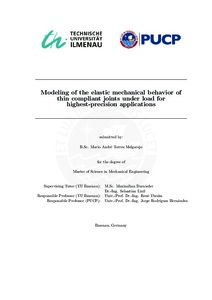| dc.contributor.advisor | Darnieder, Maximilian | |
| dc.contributor.author | Torres Melgarejo, Mario André | es_ES |
| dc.date.accessioned | 2018-10-17T00:03:17Z | es_ES |
| dc.date.available | 2018-10-17T00:03:17Z | es_ES |
| dc.date.created | 2018 | es_ES |
| dc.date.issued | 2018-10-16 | es_ES |
| dc.identifier.uri | http://hdl.handle.net/20.500.12404/12884 | |
| dc.description.abstract | For the most demanding measurement tasks in force metrology flexure hinges in compliant
mechanisms represent a key component. To enhance the mechanical properties of devices like weighing
cells, the ability of precise modeling of flexure hinges is essential. The present scientific work
focuses on the modeling of the mechanical behavior of a single flexure hinge subjected to geometric
deviations and non-ideal loading conditions as those encountered in weighing cells. The considered
hinge has a semi-circular contour and a large width compared to its minimum notch height. This
geometry is modeled using the finite element method. Requirements for a trustworthy and efficient
computation are elaborated under the consideration of geometric deviations for later parametric
studies. Analytical expressions found in the literature are compared to numerical results to prove
the validity of their assumptions for thin hinges. The model is used for studying the deviation of
the stiffness in non-ideal flexure hinges. Sources of deviation are identified and described by
parameters. The range of values for each parameter is chosen on the basis of available
manufacturing technology. Influential parameters are identified through a sensitivity analysis.
The effect of loading conditions is studied in the context of the application in weighing cells.
For the enhancement of the overall sensitivity, the stiffness of the flexure hinges can be reduced.
One option, the alteration of the geometry by adding a flexure strip in the center of the
semi-circular flexure hinge is studied in comparison to existing analytical equations. The effects
of ground tilts for a single loaded flexure hinge are investigated as a foundation for future
modeling of a tilt insensitive state of a weighing cell mechanism (autostatic state). By adjusting
the vertical position of the center of mass of the lever, the tilt sensitivity can be reduced to
zero. An approach to find the position for this state is presented considering the numerical
limitations of finite element modeling. Using this approach, the variation of the sought position
is evaluated for different values
of the design parameters. | es_ES |
| dc.description.uri | Tesis | es_ES |
| dc.language.iso | eng | es_ES |
| dc.publisher | Pontificia Universidad Católica del Perú | es_ES |
| dc.rights | info:eu-repo/semantics/openAccess | es_ES |
| dc.rights.uri | http://creativecommons.org/licenses/by-nc-nd/2.5/pe/ | * |
| dc.subject | Estructuras metálicas--Uniones | es_ES |
| dc.subject | Método de elementos finitos | es_ES |
| dc.title | Modeling of the elastic mechanical behavior of thin compliant joints under load for highest-precision applications | es_ES |
| dc.type | info:eu-repo/semantics/masterThesis | es_ES |
| thesis.degree.name | Maestro en Ingeniería Mecánica | es_ES |
| thesis.degree.level | Maestría | es_ES |
| thesis.degree.grantor | Pontificia Universidad Católica del Perú. Escuela de Posgrado | es_ES |
| thesis.degree.discipline | Ingeniería Mecánica | es_ES |
| renati.discipline | 713347 | es_ES |
| renati.level | https://purl.org/pe-repo/renati/level#maestro | es_ES |
| renati.type | http://purl.org/pe-repo/renati/type#tesis | es_ES |
| dc.publisher.country | PE | es_ES |
| dc.subject.ocde | https://purl.org/pe-repo/ocde/ford#2.03.01 | es_ES |






